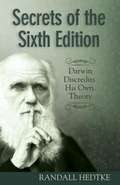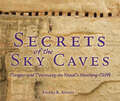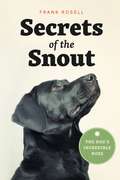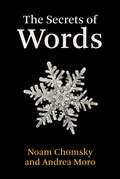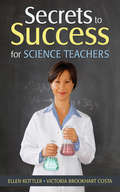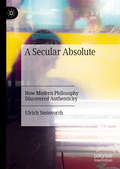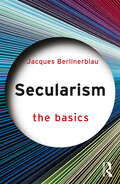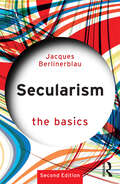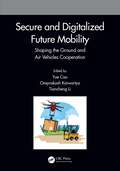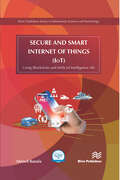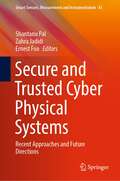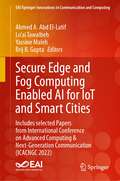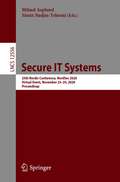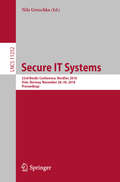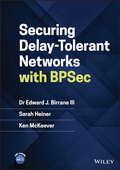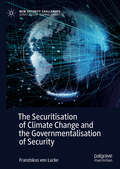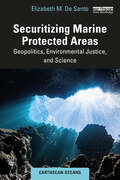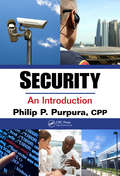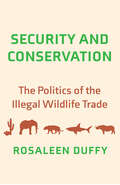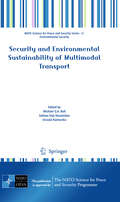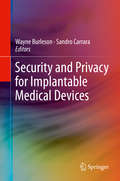- Table View
- List View
Secrets of the Oak Woodlands: Plants and Animals Among California's Oaks
by Kate MarianchildA Californian may vacation in Yosemite, Big Sur, or Death Valley, but many of us come home to an oak woodland. Yet, while common, oak woodlands are anything but ordinary. In a book rich in illustration and suffused with wonder, author Kate Marianchild combines extensive research and years of personal experience to explore some of the marvelous plants and animals that the oak woodlands nurture. Acorn woodpeckers unite in marriages of up to ten mates and raise their young cooperatively. Ground squirrels roll in rattlesnake skins to hide their scent from hungry snakes. Manzanita's rust-colored, paper-thin bark peels away in time for the summer solstice, exposing sinuous contours that are cool to the touch even on the hottest day. Conveying up-to-the-minute scientific findings with a storyteller's skill, Marianchild introduces us to a host of remarkable creatures in a world close by, a world that “rustles, hums, and sings with the sounds of wild things.”
Secrets of the Sea: The Story of Jeanne Power, Revolutionary Marine Scientist
by Evan GriffithThe curiosity, drive, and perseverance of the nineteenth-century woman scientist who pioneered the use of aquariums to study ocean life are celebrated in this gorgeous, empowering picture book.How did a nineteenth-century dressmaker revolutionize science? Jeanne Power was creative: she wanted to learn about the creatures that swim beneath the ocean waves, so she built glass tanks and changed the way we study underwater life forever. Jeanne Power was groundbreaking: she solved mysteries of sea animals and published her findings at a time when few of women&’s contributions to science were acknowledged. Jeanne Power was persistent: when records of her research were lost, she set to work repeating her studies. And when men tried to take credit for her achievements, she stood firm and insisted on the recognition due to her.Jeanne Power was inspiring, and the legacy of this pioneering marine scientist lives on in every aquarium.
Secrets of the Seasons: Orbiting the Sun in Our Backyard
by Kathleen Weidner ZoehfeldThe family from Secrets of the Garden are back in a new book about backyard science that explains why the seasons change.Alice and her friend Zack explore the reasons for the seasons. Alice's narrative is all about noticing the changes as fall turns into winter, spring, and then summer. She explains how the earth's yearlong journey around the sun, combined with the tilt in the earth's axis, makes the seasons happen. Alice's text is clear and simple, and experiential. Two very helpful—and very funny—chickens give more science details and further explanation through charts, diagrams, and sidebars. Packed with sensory details, humor, and solid science, this book makes a complicated concept completely clear for young readers—and also for the many parents who struggle to answer their kids' questions! "Several adults of my acquaintance . . . would find Secrets of the Seasons to be an eye-popping revelation." —John Lithgow, The New York Times Book Review
Secrets of the Sixth Edition
by Randall HedtkeDarwin's On the Origin of the Species was originally released in 1859, and by 1872, the sixth and last edition was published, becoming the defining text for evolutionists. This controversial work has become the foundation of modern textbooks for scientific studies in origins, though Darwin himself expressed deep doubts about his own speculations and suppositions. Secrets of the Sixth Editionby Randall Hedtke exposes the critical flaws of this landmark book by using Darwin's own words against him. Provides an examination of Darwin's research and the faulty basis of his scientific writings Filled with extensive documentation looking at the fatal flaws in Darwin's assumptions Addresses strategies for possible changes to curriculum to address weaknesses in the evolutionary hypothesis. Take an insightful look at Darwin's work and its inaccuracies from a fresh and logical perspective. You will discover the often ignored reasoning behind his own abandonment of some of the core mechanisms of evolution later in his life, though they remain unchallenged pillars of unquestioning science today. This informative and easy-to-read study boldly declares the powerful truth that only biblical creation can explain.
Secrets of the Sky Caves: Danger and Discovery on Nepal's Mustang Cliffs
by Sandra K AthansWhat's more dangerous than scaling Mount Everest? For mountaineer Pete Athans, the answer lies in the ancient kingdom of Mustang, a remote part of the Asian nation of Nepal. Long-abandoned caves built high into steep cliffs contain amazing treasures—and pose incredible dangers. Reaching these "sky caves" safely takes guts, smarts, and luck. And then there's the question of what to do with a two-thousand-year-old human skull. . . From 2007 to 2012, Pete explored Mustang's sky caves with a team that included scientists, mountain climbers, and even two children. They found mummies, murals, manuscripts, and other priceless artifacts. Follow Pete on his dangerous trips to the sky caves and discover the secrets the caves revealed.
Secrets of the Snout: The Dog’s Incredible Nose
by Frank RosellDogs and humans have worked side by side for thousands of years, and over the millennia we’ve come to depend upon our pooches as hunters, protectors, and faithful companions. But when it comes to the extraordinary quality of man’s best friend which we rely on most, the winner is clear—by a nose. In Secrets of the Snout, Frank Rosell blends storytelling and science as he sniffs out the myriad ways in which dogs have been trained to employe their incredible olfactory skills, from sussing out cancer and narcotics to locating endangered and invasive species, as well as missing persons (and golf balls). With 300 million receptors to our mere 5 million, a dog’s nose is estimated to be between 100,000 and 100 million times more sensitive than a human’s. No wonder, then, that our nasally inferior species has sought to unleash the prodigious power of canine shnozzes. Rosell here takes us for a walk with a pack of superhero sniffers including Tutta, a dog with a fine nose for fine wine; the pet-finder pooch AJ; search-and-rescue dog Barry; the hunting dog Balder; the police dogs Rasko and Trixxi; the warfare dog Lisa; the cancer detection dog Jack; Tucker, who scents floating killer whale feces; and even Elvis, who can smell when you’re ovulating. With each dog, Rosell turns his nose to the evolution of the unique olfactory systems involved, which odors dogs detect, and how they do it. A celebration of how the canine sense for scents works—and works for us—Secrets of the Snout will have dog lovers, trainers, and researchers alike all howling with delight. Exploring this most pointed of canine wonders, Rosell reveals the often surprising ways in which dogs are bettering our world, one nose at a time.
The Secrets of Words
by Noam Chomsky Andrea MoroTwo distinguished linguists on language, the history of science, misplaced euphoria, surprising facts, and potentially permanent mysteries.In The Secrets of Words, influential linguist Noam Chomsky and his longtime colleague Andrea Moro have a wide-ranging conversation, touching on such topics as language and linguistics, the history of science, and the relation between language and the brain. Moro draws Chomsky out on today&’s misplaced euphoria about artificial intelligence (Chomsky sees &“lots of hype and propaganda&” coming from Silicon Valley), the study of the brain (Chomsky points out that findings from brain studies in the 1950s never made it into that era&’s psychology), and language acquisition by children. Chomsky in turn invites Moro to describe his own experiments, which proved that there exist impossible languages for the brain, languages that show surprising properties and reveal unexpected secrets of the human mind. Chomsky once said, &“It is important to learn to be surprised by simple facts&”—&“an expression of yours that has represented a fundamental turning point in my own personal life,&” says Moro—and this is something of a theme in their conversation. Another theme is that not everything can be known; there may be permanent mysteries, about language and other matters. Not all words will give up their secrets.
Secrets to Success for Science Teachers
by Ellen Kottler Victoria B. CostaProvides teachers with practical ideas and strategies for promoting inquiry, building literacy, implementing technology, and achieving meaningful instruction in the science classroom.
Secrets to Success for Science Teachers
by Ellen Kottler Victoria Brookhart CostaThis easy-to-read guide provides new and seasoned teachers with practical ideas, strategies, and insights to help address essential topics in effective science teaching, including emphasizing inquiry, building literacy, implementing technology, using a wide variety of science resources, and maintaining student safety.
A Secular Absolute: How Modern Philosophy Discovered Authenticity
by Ulrich SteinvorthPremodern societies believed in something sacred that obliged unconditionally. Modern societies rely on fallible science. Do they also need something absolute, a secular sacred? Steinvorth analyzes the writings of modern philosophers who claim that there is an absolute norm: the norm to be rational and authentic. In his view, their claim is true if it is reinterpreted. The norm is not moral, as it was thought to be, but metaphysical, and authenticity is not self-realization, but doing things for their own sake. In discussing the pros and cons of philosophical claims on absolutes, this book spreads out the rich pool of philosophical ideas and clarifies urgent contemporary questions about what can be demanded with universal validity. It argues this is not only the principle of justice, not to harm, but also a metaphysical principle by which to find meaning in life. Moreover, it points to some consequences this principle has in politics.
Secularism: The Basics (The Basics)
by Jacques BerlinerblauSecularism: The Basics is a concise and engaging introduction to confusing and contradictory public discussions of secularism across the globe. “Secularism” must be the most confused and convoluted term in the entire global political lexicon. From New York to Paris, to Istanbul, to Addis Ababa, to New Delhi, to Montevideo, there are countless examples of politicians, religious leaders and journalists, invoking the S-word in heated debates about public education, gender, sex, national symbols, and artistic freedom. In this lively and lucid book, Jacques Berlinerblau addresses why secularism is defined in so many ways and why it so ignites people’s passions. In so doing, he explores the following important questions: What does secularism mean? Why should we care about this idea? What are the different types of secularism and what are their histories? What are the basic principles of political secularisms? Why are secularism and Atheism often confused? What is the relationship between secularism and LGBTQ rights? What opposition are secularisms up against? What does the future hold for a concept millennia in the making, but only really operationalized in the twentieth century? With a glossary of key terms, case studies, informative tables, and suggestions for further reading throughout, the book considers key philosophical, religious, anti-religious, post-modern and post-colonial arguments around secularism. This book is an ideal starting point for anyone seeking a readable introduction to the often-conflicting interpretations of one of our era’s most complex and controversial ideas.
Secularism: The Basics (The Basics)
by Jacques BerlinerblauSecularism: The Basics is a concise and engaging introduction to confusing and contradictory public discussions of secularism across the globe. In this lively and lucid book, Jacques Berlinerblau addresses why secularism is defined in so many ways and why it so ignites people’s passions. In so doing, he explores the following important questions: What does secularism mean? Why should we care about this idea? What are the different types of secularism and what are their histories? What are the basic principles of political secularisms? Why are secularism and Atheism often confused? What is the relationship between secularism and LGBTQ rights? What opposition are secularisms up against? What does the future hold for a concept millennia in the making, but only really operationalized in the last century and a half? This thoroughly updated new edition includes two new chapters on African Secularisms and the importance of Mexico in the history of political secularism. With a glossary of key terms, new and updated case studies throughout, informative tables, and suggestions for further reading, the book considers key philosophical, religious, anti-religious, and post-colonial arguments around secularism. This book continues to be an ideal starting point for anyone seeking a readable introduction to the often-conflicting interpretations of one of our era’s most complex and controversial ideas.
Secure and Digitalized Future Mobility: Shaping the Ground and Air Vehicles Cooperation
by Yue Cao Omprakash Kaiwartya Tiancheng LiThis book discusses the recent advanced technologies in Intelligent Transportation Systems (ITS), with a view on how Unmanned Aerial Vehicles (UAVs) cooperate with future vehicles. ITS technologies aim to achieve traffic efficiency and advance transportation safety and mobility. Known as aircrafts without onboard human operators, UAVs are used across the world for civilian, commercial, as well as military applications. Common deployment include policing and surveillance, product deliveries, aerial photography, agriculture, and drone racing. As the air-ground cooperation enables more diverse usage, this book addresses the holistic aspects of the recent advanced technologies in ITS, including Information and Communication Technologies (ICT), cyber security, and service management from principle and engineering practice aspects. This is achieved by providing in-depth study on several major topics in the fields of telecommunications, transport services, cyber security, and so on. The book will serve as a useful text for transportation, energy, and ICT societies from both academia and industrial sectors. Its broad scope of introductory knowledge, technical reviews, discussions, and technology advances will also benefit potential authors.
Secure and Smart Internet of Things (IoT): Using Blockchain and AI
by Ahmed BanafaBy 2020, experts forecast that up to 28 billion devices will be connected to the Internet, with only one third of them being computers, smartphones, smartwatches, and tablets. The remaining two thirds will be other “devices” – sensors, terminals, household appliances, thermostats, televisions, automobiles, production machinery, urban infrastructure and many other “things”, which traditionally have not been Internet enabled.This “Internet of Things” (IoT) represents a remarkable transformation of the way in which our world will soon interact. Much like the World Wide Web connected computers to networks, and the next evolution mobile devices connected people to the Internet and other people, IoT looks poised to interconnect devices, people, environments, virtual objects and machines in ways that only science fiction writers could have imagined. In a nutshell the Internet of Things (IoT) is the convergence of connecting people, things, data and processes; it is transforming our life, business and everything in between. Secure and Smart IoT explores many aspects of the Internet of Things and explains many of the complicated principles of IoT and the new advancements in IoT including using Fog Computing, AI and Blockchain technology.
Secure and Trusted Cyber Physical Systems: Recent Approaches and Future Directions (Smart Sensors, Measurement and Instrumentation #43)
by Shantanu Pal Zahra Jadidi Ernest FooThis book highlights the latest design and development of security issues and various defences to construct safe, secure and trusted Cyber-Physical Systems (CPS). In addition, the book presents a detailed analysis of the recent approaches to security solutions and future research directions for large-scale CPS, including its various challenges and significant security requirements. Furthermore, the book provides practical guidance on delivering robust, privacy, and trust-aware CPS at scale. Finally, the book presents a holistic insight into IoT technologies, particularly its latest development in strategic applications in mission-critical systems, including large-scale Industrial IoT, Industry 4.0, and Industrial Control Systems. As such, the book offers an essential reference guide about the latest design and development in CPS for students, engineers, designers, and professional developers.
Secure Edge and Fog Computing Enabled AI for IoT and Smart Cities: Includes selected Papers from International Conference on Advanced Computing & Next-Generation Communication (ICACNGC 2022) (EAI/Springer Innovations in Communication and Computing)
by Ahmed A. Abd El-Latif Lo’ai Tawalbeh Yassine Maleh Brij B. GuptaThis book gathers recent research in security and privacy to discuss, evaluate, and improve the novel approaches of data protection in IoT and edge and fog computing. The primary focus of the book addresses security mechanisms in IoT and edge/ fog computing, advanced secure deployments for large scaled edge/ fog computing, and new efficient data security strategy of IoT and edge/ fog computing. The book lays a foundation of the core concepts and principles of IoT and 5G security, walking the reader through the fundamental ideas. This book is aimed at researchers, graduate students, and engineers in the fields of secure IoT and edge/ fog computing. The book also presents selected papers from International Conference on Advanced Computing & Next-Generation Communication (ICACNGC 2022).
Secure IT Systems: 25th Nordic Conference, NordSec 2020, Virtual Event, November 23–24, 2020, Proceedings (Lecture Notes in Computer Science #12556)
by Mikael Asplund Simin Nadjm-TehraniThis book constitutes the refereed proceedings of the 25th Nordic Conference on Secure IT Systems, NordSec 2020, which was organized by Linköping University, Sweden, and held online during November 23-24, 2020.The 15 papers presented in this volume were carefully reviewed and selected from 45 submissions. They were organized in topical sections named: malware and attacks; formal analysis; applied cryptography; security mechanisms and training; and applications and privacy.
Secure IT Systems: 23rd Nordic Conference, NordSec 2018, Oslo, Norway, November 28-30, 2018, Proceedings (Lecture Notes in Computer Science #11252)
by Nils GruschkaThis book constitutes the refereed proceedings on the 23rd Nordic Conference on Secure IT Systems, NordSec 2018, held in Oslo, Norway, in November 2018.The 29 full papers presented in this volume were carefully reviewed and selected from 81 submissions. They are organized in topical sections named: privacy; cryptography; network and cloud security; cyber security and malware; and security for software and software development.
Securing Delay-Tolerant Networks with BPSec
by Edward J. Birrane III Sarah Heiner Ken McKeeverSecuring Delay-Tolerant Networks with BPSec One-stop reference on how to secure a Delay-Tolerant Network (DTN), written by experienced industry insiders Securing Delay-Tolerant Networks with BPSec answers the question, “How can delay-tolerant networks be secured when operating in environments that would otherwise break many of the common security approaches used on the terrestrial Internet today?” The text is composed of three sections: (1) security considerations for delay-tolerant networks, (2) the design, implementation, and customization of the BPSec protocol, and (3) how this protocol can be applied, combined with other security protocols, and deployed in emerging network environments. The text includes pragmatic considerations for deploying BPSec in both regular and delay-tolerant networks. It also features a tutorial on how to achieve several important security outcomes with a combination of security protocols, BPSec included. Overall, it covers best practices for common security functions, clearly showing designers how to prevent network architecture from being over-constrained by traditional security approaches. Written by the lead author and originator of the BPSec protocol specification, Securing Delay-Tolerant Networks (DTNs) with BPSec includes information on: The gap between cryptography and network security, how security requirements constrain network architectures, and why we need something different DTN stressing conditions, covering intermittent connectivity, congested paths, partitioned topologies, limited link state, and multiple administrative controls Securing the terrestrial internet, involving a layered approach to security, the impact of protocol design on security services, and securing the internetworking and transport layers A delay-tolerant security architecture, including desirable properties of a DTN secure protocol, fine-grained security services, and protocol augmentation Securing Delay-Tolerant Networks (DTNs) with BPSec is a one-stop reference on the subject for any professional operationally deploying BP who must use BPSec for its security, including software technical leads, software developers, space flight mission leaders, network operators, and technology and product development leaders in general.
The Securitisation of Climate Change and the Governmentalisation of Security (New Security Challenges)
by Franziskus von LuckeThis book provides an in-depth analysis of the securitisation of climate change in the US, Germany and Mexico and offers a rethinking of securitisation theory. Resting on a Foucauldian governmentality approach, it discusses how different climate security discourses have transformed the political handling of climate change and affected policies, practices and institutions. Going beyond the literature’s predominant focus on the global level, it gives a fine-grained examination of the political and institutional changes in different national contexts. Drawing on the governmentalisation of security, the book develops a new understanding of securitisation that focuses on the role of power. In doing so, it provides new insights into the transformative potential of linking climate change to security but also highlights the political and normative pitfalls of securitisation. ‘In this important book, Franziskus von Lucke provides a theoretically sophisticated and empirically rich account of the relationship between security and climate change. Developing a Foucauldian-inspired account of securitization, the book rejects blanket or universal claims about the climate change- security relationship, instead insisting on the need to critically examine how the securitization of climate change plays out in particular empirical contexts. Exploring the cases of the US, Germany and Mexico, von Lucke points to distinctive dynamics of securitization in these settings, with different implications for the practices these in turn encourage. Ultimately, this book constitutes an important addition to literature on the relationship between climate change and security, while developing a distinct and nuanced account of securitization that will be of interest to a wide range of scholars of security in international relations.’—Associate Professor Matt McDonald is a Reader in International Relations at the University of Queensland, Australia ‘In 2019 a number of states and other actors (notably the European Union) have made climate emergency declarations. It is therefore more important than ever to understand what the securitization of the climate means. That is: Who can securitize? What security measures are likely/ deemed legitimate by relevant audiences? How does securitization affect the population within and outside a securitizing state? And perhaps most importantly of all, will it succeed? Franziskus von Lucke’s carefully researched book offers answers to all of these questions and many others besides. von Lucke proceeds by examining with the US, Mexico and Germany, three real-life empirical cases of climate securitization. Each one provides unique insights that enable a fuller understanding of climate security. Accessibly written this is a must read for scholars and practitioners alike.’ —Dr Rita Floyd, University of Birmingham, UK, author of The Morality of Security: A theory of just Securitization, CUP, 2019 With great empirical detail and conceptual clarity, the book compares discourses and practices of climate security in different contexts. An essential reading for anyone interested in international climate politics, securitization theory, governmentality and the notion of power in International Relations. —Dr Delf Rothe, Institute for Peace Research and Security Policy Hamburg at the University of Hamburg, Germany
Securitizing Marine Protected Areas: Geopolitics, Environmental Justice, and Science (Earthscan Oceans)
by Elizabeth M. De SantoThis book presents a novel examination of Marine Protected Areas within a security context, bridging science, policy, and geopolitics, and addressing the often-under-emphasized aspect of environmental justice.The book argues that Marine Protected Areas (MPAs) are not only a critical tool for protecting marine biodiversity in a changing climate, but they also play an important role at the intersection of geopolitics and environmental justice, and they provide a case study of environmental governance at the science-policy interface. The book takes an interdisciplinary and critical approach and builds on the author's two decades of experience working in this field. Geopolitically, it explores the ways in which MPAs provide footprints for influence and access to resources far from home for nations with overseas territories. MPAs also raise important issues connected to equity, environmental justice, and social justice, including access to resources and participation in environmental decision-making processes, key aspects for achieving long-term conservation goals. The book also demonstrates how MPAs are a critical lens for understanding how policy makers cope with scientific uncertainty, and the necessity of well-designed and precautionary science advisory processes. While the ecological contribution of MPAs is paramount, social issues and geopolitical considerations are often less obvious in the discourse underpinning MPAs, and the resulting tensions can undermine long-term conservation objectives. By applying the three lenses of geopolitics, environmental justice and science, this book provides key insights to help the international community moving past the 2030 biodiversity targets and beyond, towards a future of meaningful, equitable, and effective conservation approaches.This book will be of great interest to students and scholars of biodiversity conservation, marine studies, political geography, environmental governance, and science-policy studies. It will also be of interest to marine conservation governance professionals and policymakers.
Security: An Introduction
by Philip P. PurpuraToday, threats to the security of an organization can come from a variety of sources- from outside espionage to disgruntled employees and internet risks to utility failure. Reflecting the diverse and specialized nature of the security industry, Security: An Introduction provides an up-to-date treatment of a topic that has become increasingly comple
Security and Conservation: The Politics of the Illegal Wildlife Trade
by Rosaleen DuffyAn exploration of the scale, practical reality, and future implications of the growing integration of biodiversity conservation with global security concerns &“There are few keener observers of international biodiversity conservation than Rosaleen Duffy. With a ferocity of purpose, she investigates the tenuous connection and nuances among illegal wildlife trade, terrorism threats, and national security.&”—Steven R. Brechin, Rutgers University, New Brunswick Debates regarding environmental security risks have generally focused on climate change and geopolitical water conflicts. Biodiversity conservation, however, is increasingly identified as a critical contributor to national and global security. The illegal wildlife trade is often articulated as a driver of biodiversity losses, and as a source of finance for organized crime networks, armed groups, and even terrorist networks. Conservationists, international organizations, and national governments have raised concerns about &“convergence&” of wildlife trafficking with other serious offenses, including theft, fraud, corruption, drugs and human trafficking, counterfeiting, firearms smuggling, and money laundering. In Security and Conservation, Rosaleen Duffy examines the scale, practical reality, and future implications of the growing integration of biodiversity conservation with global security concerns. Duffy takes a political ecology approach to develop a deeper understanding of how and why wildlife conservation turned toward security‑oriented approaches to tackle the illegal wildlife trade.
Security and Environmental Sustainability of Multimodal Transport
by Solmaz Haji Hosseinloo Michael Bell Urszula KanturskaThis book is the result of a NATO Advanced Research Workshop which was held at Imperial College London in January 2009. It features contributions from a range of international experts covering topics related to the transport of hazardous materials, such as routeing and scheduling, risk assessment, security, and social and environmental exposure. There is also a broad look at the implications of climate change for transport. This unique resource offers a deep understanding of hazardous material transportation and concomitant security and environmental problems. The risks involved in the transport of dangerous goods are shown to arise mainly from the location of the sources and destinations as well as the timing of deliveries. Environmental concerns, including the implications of climate change for transport, provide a useful context for the more analytical material. The book is timely and topical as the subjects covered have become a focus for public concern in recent years, due in part to terrorist attacks on transport systems. This comprehensive reference provides examples from around the world, illustrating the diversity of regulations which apply to the handling and transport of dangerous goods. It also provides interesting insights into the global energy supply chain and describes on-going work on establishing network vulnerability.
Security and Privacy for Implantable Medical Devices
by Wayne Burleson Sandro CarraraThis book presents a systematic approach to analyzing the challenging engineering problems posed by the need for security and privacy in implantable medical devices (IMD). It describes in detail new issues termed as lightweight security, due to the associated constraints on metrics such as available power, energy, computing ability, area, execution time, and memory requirements. Coverage includes vulnerabilities and defense across multiple levels, with basic abstractions of cryptographic services and primitives such as public key cryptography, block ciphers and digital signatures. Experts from Computer Security and Cryptography present new research which shows vulnerabilities in existing IMDs and proposes solutions. Experts from Privacy Technology and Policy will discuss the societal, legal and ethical challenges surrounding IMD security as well as technological solutions that build on the latest in Computer Science privacy research, as well as lightweight solutions appropriate for implementation in IMDs.



